
Athletics is a group of sporting events that involves competitive running, jumping, throwing, and walking. The most common types of athletics competitions are track and field, road running, cross country running, and racewalking.

Track and field is a sport that includes athletic contests based on running, jumping, and throwing skills. The name is derived from where the sport takes place, a running track and a grass field for the throwing and some of the jumping events. Track and field is categorized under the umbrella sport of athletics, which also includes road running, cross country running and racewalking.
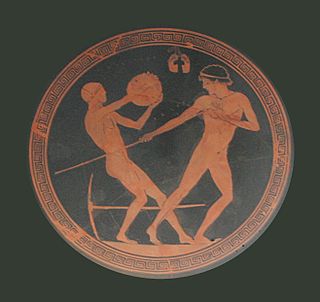
A pentathlon is a contest featuring five events. The name is derived from Greek: combining the words pente (five) and -athlon (competition). The first pentathlon was documented in Ancient Greece and was part of the Ancient Olympic Games. Five events were contested over one day for the Ancient Olympic pentathlon, starting with the long jump, javelin throwing, and discus throwing, followed by the stadion and wrestling. Pentathletes were considered to be among the most skilled athletes, and their training was often part of military service—each of the five events in the pentathlon was thought to be useful in war or battle.

The pentathlon or women's pentathlon is a combined track and field event in which each woman competes in five separate events over one day. The distance or time for each event is converted to points via scoring tables, with the overall ranking determined by total points. Since 1949 the events have been sprint hurdling, high jump, shot put, long jump, and a flat race. The sprint hurdles distance was 80 m outdoors until 1969 and thereafter 100 m; in indoor pentathlon the distance is 60 m. The flat race was 200 m until 1976 and thereafter 800 m. In elite-level outdoor competition, the pentathlon was superseded in 1981 by the heptathlon, which has seven events, with both 200 m and 800 m, as well as the javelin throw. Pentathlon is still contested at school and masters level and indoors.

Athletics has been contested at every Summer Olympics since the birth of the modern Olympic movement at the 1896 Summer Olympics. The athletics program traces its earliest roots to events used in the ancient Greek Olympics. The modern program includes track and field events, road running events, and race walking events. Cross country running was also on the program in earlier editions but it was dropped after the 1924 Summer Olympics.

Wheelchair racing is the racing of wheelchairs in track and road races. Wheelchair racing is open to athletes with any qualifying type of disability, amputees, spinal cord injuries, cerebral palsy and partially sighted. Athletes are classified in accordance with the nature and severity of their disability or combinations of disabilities. Like running, it can take place on a track or as a road race. The main competitions take place at the Summer Paralympics which wheelchair racing and athletics has been a part of since 1960. Competitors compete in specialized wheelchairs which allow the athletes to reach speeds of 30 km/h (18.6 mph) or more. It is one of the most prominent forms of Paralympic athletics.
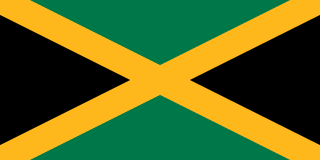
Jamaica made its Paralympic Games début at the 1968 Summer Paralympics in Tel Aviv. It competed again in 1972, was absent in 1976, returned in 1980, and has competed at every edition of the Summer Paralympics since then. Jamaica has never taken part in the Winter Paralympics.
Zipora Rubin-Rosenbaum is an Israeli athlete who has won 30 Paralympic medals. She has represented Israel at the Summer Paralympic Games seven times and has competed in athletics, swimming, table tennis, and wheelchair basketball at the Games.
Ronald Arthur "Ron" Stein was an American athlete who competed at the inaugural Summer Paralympic Games held in Rome in 1960.

Daphne Jean Hilton was an Australian Paralympic competitor. She was the first Australian woman to compete at the Paralympic Games. She won fourteen medals in three Paralympics in archery, athletics, fencing, swimming, and table tennis from 1960 to 1968.

Also known as the 13th Stoke Mandeville Games, the 1964 Summer Paralympics was the 2nd Paralympic Games. Hosted in Tokyo, the games ran from 8 to 12 November. Australia won a total of 30 medals and finished fourth on the medal tally behind Italy (3rd), Great Britain (2nd) and the United States (1st). Australia competed in 6 of the 9 sports at the Games, winning medals in each of those sports, but was most successful in the pool, winning a majority of their medals in swimming events.
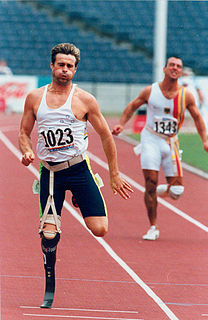
T44 is a disability sport classification for disability athletics, applying to "Single below knee amputation or an athlete who can walk with moderately reduced function in one or both legs." It includes ISOD A4 and A9 classes.
T52 is disability sport classification for disability athletics. People in this class have good shoulder and upper body control, but lack fine motor skills in their arms and hands. They have no to limited trunk and leg function. The class includes people with a number of different types of disabilities including spinal cord injuries. Similar classifications are T51, T53 and T54.

Athletics New Brunswick is the provincial organizing body for track and field, cross country running, race walking, and road racing in New Brunswick. The organization is the official branch of Athletics Canada and was incorporated in 1991 to replace the former organization, The New Brunswick Track and Field Association. The organization offers programs to affiliated and non-affiliated participants annually, reaching some 3000 athletes, coaches, officials, and volunteers across the province.
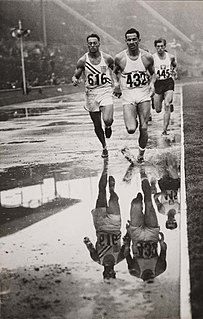
Combined events at the Summer Olympics have been contested in several formats at the multi-sport event. There are two combined track and field events in the current Olympic athletics programme: a men's decathlon and a women's heptathlon.

In the sport of athletics, pentathlons have taken various forms over the history of the sport, typically incorporating five track and field events. The only version of the event to remain at a high level of contemporary competition is the women's indoor pentathlon, which is present on the programme for the IAAF World Indoor Championships.
T41 is disability sport classification for disability athletics. It is used in track athlete and has a sister classification F41 for field athletes. This is a classification for athletes with short stature.

The Belgian Athletics Championships is an annual outdoor track and field competition organised by the Royal Belgian Athletics League, which serves as the national championship for the sport in Belgium.
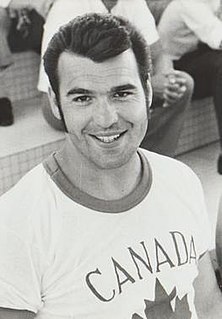
Eugene "Gene" Reimer was a Canadian wheelchair Paralympic athlete who won 10 Paralympic medals and 50 Canadian and Pan-American medals from 1968 to 1980. Having polio at an early age, he was a member of the wheelchair basketball team Vancouver Cable Cars alongside Terry Fox and Rick Hansen. In 1972, Reimer became the first person with a disability to be named Canada's Outstanding Male Athlete of the Year and to be inducted into the Order of Canada.

The Dutch Athletics Championships is an annual outdoor track and field competition organised by the Royal Dutch Athletics Federation, which serves as the national championship for the sport in the Netherlands. It is typically held as a two- or three-day event in the Dutch summer, ranging from late June to early August. The venue of the championships varies, though Amsterdam's Olympic Stadium has been a regular host.














